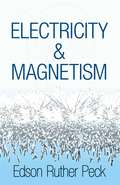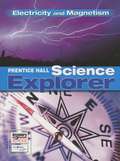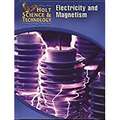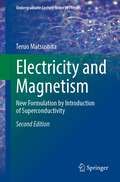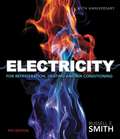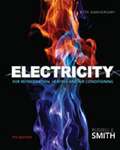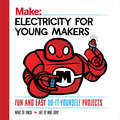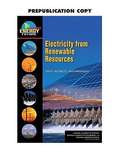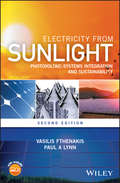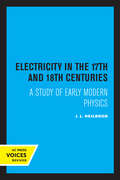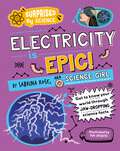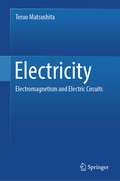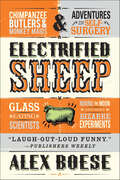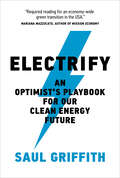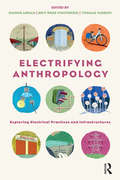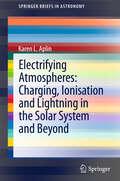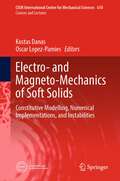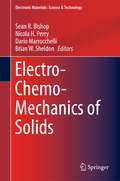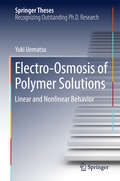- Table View
- List View
Electricity and Magnetism (Dover Books on Physics)
by Edson Ruther PeckThis classic 1953 text for advanced undergraduates has been used by generations of physics majors. Requiring only some background in general physics and calculus, it offers in-depth coverage of electricity and magnetism and features problems at the end of each chapter.Starting with an introductory chapter on electrostatics, the treatment advances to the electrostatic field of free charges; dielectric theory; electrostatic energy, force, and capacitance; electric current; and direct-current circuits. Subsequent topics include steady-state magnetism, electromagnetic induction, magnetic properties of matter, transient currents, analysis of alternating-current circuits, Maxwell's equations, and electromagnetic waves.
Electricity and Magnetism (Interactive Science, Chapter #9)
by Michael J. Padilla Don Buckley Zipporah Miller Kathryn Thornton [et al.]Learn more about how electricity and magnetic energy transform and move objects.
Electricity and Magnetism (Prentice Hall Science Explorer)
by Camille L. WainwrightPrentice Hall Science Explorer, Electricity and Magnetism by Camille L. Wainwright.
Electricity and Magnetism (Prentice Hall Science Explorer)
by Camille L. WainwrightScience textbook for middle school
Electricity and Magnetism (Prentice Hall Science Integrated Learning System)
by Prentice-Hall StaffA science book.
Electricity and Magnetism for Mathematicians
by Thomas A. GarrityThis text is an introduction to some of the mathematical wonders of Maxwell's equations. These equations led to the prediction of radio waves, the realization that light is a type of electromagnetic wave, and the discovery of the special theory of relativity. In fact, almost all current descriptions of the fundamental laws of the universe can be viewed as deep generalizations of Maxwell's equations. Even more surprising is that these equations and their generalizations have led to some of the most important mathematical discoveries of the past thirty years. It seems that the mathematics behind Maxwell's equations is endless. The goal of this book is to explain to mathematicians the underlying physics behind electricity and magnetism and to show their connections to mathematics. Starting with Maxwell's equations, the reader is led to such topics as the special theory of relativity, differential forms, quantum mechanics, manifolds, tangent bundles, connections, and curvature.
Electricity and Magnetism: Holt Science & Technology Short Course N
by Holt Rinehart Winston StaffThe book has a Reading Warm-Up at the beginning of every section provides the student with the section's objectives and key terms. A Reading Strategy at the beginning of every section provides tips to help students organize and remember the information covered in the section.
Electricity and Magnetism: New Formulation by Introduction of Superconductivity (Undergraduate Lecture Notes in Physics)
by Teruo MatsushitaThis book is a very comprehensive textbook covering in great depth all the electricity and magnetism. The 2nd edition includes new and revised figures and exercises in many of the chapters, and the number of problems and exercises for the student is increased.In the 1st edition, emphasis much was made of superconductivity, and this methodology will be continued in the new edition by strengthening of the E-B analogy. Many of the new exercises and problems are associated with the E-B analogy, which enables those teaching from the book to select suitable teaching methods depending on the student’s ability and courses taken, whether physics, astrophysics, or engineering.Changes in the chapters include a detailed discussion of the equivector-potential surface and its correspondence between electricity and magnetism. The shortcomings of using the magnetic scalar potential are also explained. The zero resistivity in a magnetic material showing perfect diamagnetism can be easily proved.This textbook is an ideal text for students, who are competent in calculus and are taking physics, astrophysics, or engineering at degree level. It is also useful as a reference book for the professional scientist.
Electricity for Refrigeration, Heating, and Air Conditioning
by Russell E. SmithThe ideal book for students and beginning technicians, this Ninth Edition of ELECTRICITY FOR REFRIGERATION, HEATING, AND AIR CONDITIONING provides readers with the basic electrical principles necessary to understand today's modern control systems. The book's practical approach allows readers to focus exclusively on the electronics information they will use in the field, without bogging them down in unnecessary theory. The book focuses on helping readers master systematic diagnosis and troubleshooting methods and procedures that will enable them to become highly-skilled, professional HVAC-R service technicians.
Electricity for Refrigeration, Heating, and Air Conditioning, 9th Edition
by Russell E. SmithThe Lab Manual is a valuable tool designed to enhance your students' lab experience. Lab activities, objectives, materials lists, step-by-step procedures, illustrations, and review questions are commonly included.
Electricity for Young Makers: Fun and Easy Do-It-Yourself Projects
by Marc De VinckLearning to be a maker has never been more fun. Lavishly illustrated with cartoons and drawings, this book guides the reader through six hands-on projects using electricity. Discover the electrical potential lurking in a stack of pennies - enough to light up an LED or power a calculator! Launch a flying LED copter into the air. Make a speaker that plays music from an index card. Build working motors from a battery, a magnet, and some copper wire. Have fun while learning about and exploring the world of electricity. The projects in this book illuminate such concepts as electric circuits, electromagnetism, electroluminescence, the Lorentz force and more. You'll be amazed by the results you get with a handful of simple materials.
Electricity from Renewable Resources: Status, Prospects, and Impediments
by National Academy Of Sciences National Academy of Engineering National Research Council of the National AcademiesA component in the America's Energy Future study, Electricity from Renewable Resources examines the technical potential for electric power generation with alternative sources such as wind, solar-photovoltaic, geothermal, solar-thermal, hydroelectric, and other renewable sources. The book focuses on those renewable sources that show the most promise for initial commercial deployment within 10 years and will lead to a substantial impact on the U.S. energy system. A quantitative characterization of technologies, this book lays out expectations of costs, performance, and impacts, as well as barriers and research and development needs. In addition to a principal focus on renewable energy technologies for power generation, the book addresses the challenges of incorporating such technologies into the power grid, as well as potential improvements in the national electricity grid that could enable better and more extensive utilization of wind, solar-thermal, solar photovoltaics, and other renewable technologies.
Electricity from Sunlight: Photovoltaic-Systems Integration and Sustainability
by Paul A. Lynn Vasilis M. FthenakisPraised for its visual appeal, conversational style and clear explanation of complex ideas with minimal mathematics, Electricity from Sunlight has been thoroughly revised and updated to reflect advances in the global PV market, economics and installed capacity. Key features of the 2nd edition include: A timely update of the advances of photovoltaics (PV), with major new material on grid-connected systems. More in-depth treatment of PV scientific principles, solar cells, modules, and systems. Up-to-date coverage of the PV market including conversion efficiencies and the expansion of grid-friendly power plants. End-of-chapter questions to support instructors and students through guided self-study. New chapters on manufacturing processes and on materials and other resources availability. New large-scale PV section covering the growth of global capacity, utility-scale PV and affordable solutions for intermittency. Systems analysis of new applications empowered by low-cost PV, such as energy storage and water desalination. Significantly expanded economics and environmental section explaining leveled cost of electricity versus upfront costs, energy return on investments, and lifecycle analysis. Electricity from Sunlight: Photovoltaics Systems Integration and Sustainability, Second Edition is an essential primer for new entrants to the PV industry, needing a basic appreciation of complete PV systems, and to students on undergraduate and graduate courses on renewable energy and photovoltaics. It also offers a unique treatise of the sustainability of emerging transformative technologies, which makes it useful to both system analysts and energy policy strategists.
Electricity in the 17th and 18th Centuries: A Study of Early Modern Physics
by J. L. HeilbronThis title is part of UC Press's Voices Revived program, which commemorates University of California Press’s mission to seek out and cultivate the brightest minds and give them voice, reach, and impact. Drawing on a backlist dating to 1893, Voices Revived makes high-quality, peer-reviewed scholarship accessible once again using print-on-demand technology. This title was originally published in 1979.
Electricity is Epic! (Surprised by Science #6)
by Sabrina Rose Science GirlBe surprised by the astonishing science of electricity, with Sabrina Rose, AKA Science Girl, the internet's most inspiring curator of facts and observations of our wonderful world - making it easy for all readers to come to love science!Surprised by Science: Electricity is Epic brings an attention-grabbing and accessible set of electricity facts to life! Doing what she's famous for online, Sabrina Rose dives into the most surprising details of the world of electricity to explore the science at work. From lightning strikes to shocking static; from aurora in the sky to electricity in the human body - this series is perfect for inquisitive children age 7 and up, and all fans of Science Girl.Contents: What is Electricity? / The Spark of Discovery / The Power of the Sun / All Charged Up / The Perfect Storm / Electricity in Us / Supercharged Creatures / An Electrifying Connection / Electrical Spectacle / Natural Wonders / Plug It In / Surprised by Scientific Discoveries: Franklin & Edison / Surprised by Scientific Discoveries: Tesla & Faraday / Glossary and Further Information / IndexSurprised by Science is a series of books that takes the inspiring communication and research skills of Science Girl's hugely popular platform and distills it on the page, with funny and engaging illustrations by Pipi Sposito paired with photos of the real-life science in action. The series includes: Electricity is Epic!; Plants are Powerful!; Forces are Fantastic!; Sound is Sensational!; Animals are Awesome!; Human Bodies are Brilliant!
Electricity: Electromagnetism and Electric Circuits
by Teruo MatsushitaThis book leads students to learn electromagnetism and then moves to chapters about electric circuits. It aims to give an understanding of electromagnetism which gives a fast way to master the features of circuit elements such as resistors, capacitors, and coils that compose electric circuits. The author provides chapters on electromagnetism and electric circuits separately and gives a chapter explaining the correlation between them in detail.In the chapters for electric circuit, DC electric circuits, transient and steady response of AC electric circuits are treated. AC circuit theory is introduced for describing the phenomena in circuits. Theoretical treatments such as branch current method, closed current method, and node potential method are also introduced to show the validity of solution methods that have been used in the book. The book can serve as a compact textbook for lectures, as an introduction for hardware system and electric control systems, and mechanical systems. Chapters for electromagnetism or ones for electric circuits are suitable for a lecture over a semester.
Electrified Sheep: Glass-eating Scientists, Nuking The Moon, And More Bizarre Experiments
by Alex Boese"Perfect summertime reading—preferably with a friend nearby who can be constantly interrupted with unsettling facts." —Daily Mail (UK )Benjamin Franklin was a pioneering scientist, leader of the Enlightenment, and a founding father of the United States. But perhaps less well known is that he was also the first person to use mouth-to-mouth resuscitation on an electric-shock victim. Odder still, it was actually mouth-to-beak resuscitation on a hen that he himself had shocked. Welcome to some of the weirdest and most wonderful experiments ever conducted in the name of science. Filled with stories of science gone strange, Electrified Sheep is packed with eccentric characters, irrational obsessions, and extreme experiments. Watch as scientists attempt to nuke the moon, wince at the doctor who performs a self-appendectomy, and catch the faint whiff of singed wool from an electrified sheep.
Electrify: An Optimist's Playbook for Our Clean Energy Future
by Saul GriffithAn optimistic--but realistic and feasible--action plan for fighting climate change while creating new jobs and a healthier environment: electrify everything.Climate change is a planetary emergency. We have to do something now—but what? Saul Griffith has a plan. In Electrify, Griffith lays out a detailed blueprint—optimistic but feasible—for fighting climate change while creating millions of new jobs and a healthier environment. Griffith&’s plan can be summed up simply: electrify everything. He explains exactly what it would take to transform our infrastructure, update our grid, and adapt our households to make this possible. Billionaires may contemplate escaping our worn-out planet on a private rocket ship to Mars, but the rest of us, Griffith says, will stay and fight for the future. Griffith, an engineer and inventor, calls for grid neutrality, ensuring that households, businesses, and utilities operate as equals; we will have to rewrite regulations that were created for a fossil-fueled world, mobilize industry as we did in World War II, and offer low-interest &“climate loans.&” Griffith&’s plan doesn&’t rely on big, not-yet-invented innovations, but on thousands of little inventions and cost reductions. We can still have our cars and our houses—but the cars will be electric and solar panels will cover our roofs. For a world trying to bounce back from a pandemic and economic crisis, there is no other project that would create as many jobs—up to twenty-five million, according to one economic analysis. Is this politically possible? We can change politics along with everything else.
Electrifying Anthropology: Exploring Electrical Practices and Infrastructures (Criminal Practice Ser.)
by Brit Ross Winthereik Thomas Yarrow Simone Abram Anjan SarkarWhat kinds of expertise and knowledge relate to electricity, and where is the space for alternative voices? How can the new roles for electricity in social and cultural life be acknowledged? How can we speak about ‘it’ in its own right while acknowledging that electricity is not one thing? This book re-describes electricity and its infrastructures using insights from anthropology and science and technology studies, raising fascinating questions about the contemporary world and its future. Through ethnographic studies of bulbs, bicycles, dams, power grids and much more, the contributors shed light on practices that are often overlooked, showing how electricity is enacted in multiple ways. Electrifying Anthropology moves beyond the idea of electricity as an immovable force, and instead offers a set of potential trajectories for thinking about electricity and its effects in contemporary society. With new contributions on an emerging area of research, this timely collection will be of value to students and scholars of anthropology, science and technology studies, geography and engineering.
Electrifying Atmospheres: Charging, Ionisation and Lightning in the Solar System and Beyond
by Karen L. AplinElectrical processes take place in all planetary atmospheres. There is evidence for lightning on Venus, Jupiter, Saturn, Uranus and Neptune, it is possible on Mars and Titan, and cosmic rays ionise every atmosphere, leading to charged droplets and particles. Controversy surrounds the role of atmospheric electricity in physical climate processes on Earth; here, a comparative approach is employed to review the role of electrification in the atmospheres of other planets and their moons. This book reviews the theory, and, where available, measurements, of planetary atmospheric electricity, taken to include ion production and ion-aerosol interactions. The conditions necessary for a global atmospheric electric circuit similar to Earth's, and the likelihood of meeting these conditions in other planetary atmospheres, are briefly discussed. Atmospheric electrification is more important at planets receiving little solar radiation, increasing the relative significance of electrical forces. Nucleation onto atmospheric ions has been predicted to affect the evolution and lifetime of haze layers on Titan, Neptune and Triton. For planets closer to Earth, heating from solar radiation dominates atmospheric circulations. Mars may have a global circuit analogous to the terrestrial model, but based on electrical discharges from dust storms, and Titan may have a similar global circuit, based on transfer of charged raindrops. There is an increasing need for direct measurements of planetary atmospheric electrification, in particular on Mars, to assess the risk for future unmanned and manned missions. Theoretical understanding could be increased by cross-disciplinary work to modify and update models and parameterisations initially developed for a specific atmosphere, to make them more broadly applicable to other planetary atmospheres. The possibility of electrical processes in the atmospheres of exoplanets is also discussed.
Electro- and Magneto-Mechanics of Soft Solids: Constitutive Modelling, Numerical Implementations, and Instabilities (CISM International Centre for Mechanical Sciences #610)
by Kostas Danas Oscar Lopez-PamiesThis book examines the electro- and magneto-mechanics of soft composite materials and structures, and focuses on magnetorheological elastomers (MREs) and dielectric elastomer composites (DECs), which are composite materials that comprise ferromagnetic and high-dielectric/conducting filler nano- and micro-particles embedded in a soft polymeric matrix. This gives rise to a coupled magneto- and electro-mechanical response at the macroscopic (order of millimeters and larger) scale when they are subjected to magneto- electro-mechanical external stimuli. While such MRE and DEC materials and devices can become unstable at some critical electro-magneto-mechanical loading, their response may be well controlled in the post-instability regime. Moreover, recent advances on the complete electro-magneto-mechanical coupling are presented. All those aforementioned features motivate the operation of these devices in this unstable region to obtain controlled pattern formation, soft robotic motion andartificial muscles, controllable band-gap acoustic and electromagnetic properties, energy harvesting as well as actively controlled stiffness (for cell-growth). The book contains four individual chapters covering work on the fundamentals (O. Lopez-Pamies) and the modeling (M. Gei) of electroactive solids, the modeling of magnetoactive solids (K. Danas), and the analysis of elastic instabilities (Y. Fu).
Electro-Chemo-Mechanical Properties of Solid Electrode Surfaces
by Masahiro SeoThis book deals with the electro-chemo-mechanical properties characteristic of and unique to solid electrode surfaces, covering interfacial electrochemistry and surface science. Electrochemical reactions such as electro-sorption, electro-deposition or film growth on a solid electrode induce changes in surface stress or film stress that lead to transformation of the surface phase or alteration of the surface film. The properties of solid electrode surfaces associated with the correlation between electrochemical and mechanical phenomena are named “electro-chemo-mechanical properties”. The book first derives the surface thermodynamics of solid electrodes as fundamentals for understanding the electro-chemo-mechanical properties. It also explains the powerful techniques for investigating the electro-chemo-mechanical properties, and reviews the arguments for derivation of surface thermodynamics of solid electrodes. Further, based on current experimental findings and theories, it discusses the importance of the contribution of surface stress to the transformation of surface phases, such as surface reconstruction and underpotential deposition in addition to the stress evolution during film growth and film reduction. Moreover, the book describes the nano-mechanical properties of solid surfaces measured by nano-indentation in relation to the electro-chemo-mechanical properties. This book makes a significant contribution to the further development of numerous fields, including electrocatalysis, materials science and corrosion science.
Electro-Chemo-Mechanics of Solids
by Sean R. Bishop Nicola H. Perry Dario Marrocchelli Brian W. SheldonThis book brings together a collection of chapters that focus on the relationship among electrical, chemical, and mechanical properties and the study of adjusting one property through the control of another, namely, Electro-Chemo-Mechanics (ECM). The authors examine how this relationship can result in beneficial properties, such as mixed ionic and electronic conductivity, in oxides, upon oxygen deficiency or lithium insertion (electro-chemo) and/or changes in ionic and electronic mobility observed in strained systems (electro-mechano). They also consider how ECM interactions can be responsible for large stresses from non-stoichiometry induced lattice dilation (chemo-mechano). While many volumes are available devoted to the study of the origins and characteristics of electro-chemical relationships, they form the well-known field of electrochemistry, this volume is highly novel in its examination of the corresponding electro-mechanical, chemo-mechanical, and electro-chemo-mechanical relationships. The book is ideal for researchers and design engineers interested in energy storage and conversion and the electrical and mechanical properties of materials.
Electro-Osmosis of Polymer Solutions
by Yuki UematsuThis thesis focuses on the theoretical description of electro-osmosis of polymer solutions. In particular, it emphasizes the importance of considering non-uniform profiles of the solution viscosity and polymer concentration near a solid surface. The thesis begins with an introduction to fundamental theories and experimental observations for beginners in this field, concerning electrolyte solutions, electric double layers, and electrokinetics. In Chapter 2, the author discusses the linear response of electro-osmotic flow with respect to applied electric fields in aqueous polyelectrolyte solutions, and predicts a possibility of flow reversal caused by oppositely charged polyelectrolytes adsorbed on a charged surface. In Chapter 3, the author extends the discussion to non-linear electro-osmotic flow driven by applied electric fields in neutral polymer solutions. The dynamics of polymers are modeled and simulated using Brownian dynamics and kinetic theory. Finally, the thesis is summarized in Chapter 4. The introduction provides a comprehensive review of electrokinetics for graduate students and researchers interested in soft matter physics. An additional attraction is that readers can effectively learn various theoretical approaches to electro-osmosis.
